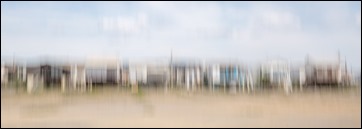Having rain feature in the weather forecast most of the time is depressing enough. It’s even more frustrating when rain does not feature in the forecast but turns up anyway. Such was the case this morning. The campsite had dried just a little but now, after two hours of mostly continuous morning rain, the puddles and mud-wallows were back with a vengeance. All we needed was, to quote Flanders and Swann, a couple of hippopotami.
During our first escape to Gruissan, Francine had seen some paintings featuring rather impressionistic representations of a subject at an area known as La Plage des Chalets in Gruissan Plage, namely the chalets themselves. The chalets are built on stilts and are arranged in a sort of chalets village, with intersecting streets. Frankly, it can look a little seedy but nothing like as seedy as Jaywick Sands near Clacton in the UK. Once you get used to them, these can look like an architectural curiosity. They are a subject that definitely benefits from an impressionist approach rather than a photographically precise representation. The painted art works all had an unrealistic colour tint. Francine fancied a go with her camera, skipping the colour tints, and why not, indeed? We decided to escape the rain again and go for an experiment.
Just as with our first escape, 10kms east of Fanjeaux the rain ceased and the skies had brightened a little, solid dark grey becoming broken lighter grey. After 50kms, passing the Corbières region, the clouds had given way to more or less uninterrupted blue. It’s worth a few tolls and more fuel.
‘T was a Saturday morning and the Gruissan market was in full swing so parking spaces were at more of a premium than on our initial visit. However, following signs to La Plage des Chalets, we were surprised at just how few people were there. We parked and began looking for a suitable line of chalets. What constituted suitable was a bit of a guess but we thought that less tall concrete poles, strung with black cabling, sticking up high and fowling the roof line would be better.
 The wind was once again very strong. modest sand dunes collected in seemingly random spots along the walkway, caused by the wind eddying around gaps in the low wall according to some complex fluid mechanics. The wind was providing great fun for collections of wind surfers and kite fliers alike; I don’t recall ever seeing a wind surfer travelling quite so fast. The first items of interest to receive the camera treatment were lines of stakes casting razor-sharp shadows on the fine, dry sand.
The wind was once again very strong. modest sand dunes collected in seemingly random spots along the walkway, caused by the wind eddying around gaps in the low wall according to some complex fluid mechanics. The wind was providing great fun for collections of wind surfers and kite fliers alike; I don’t recall ever seeing a wind surfer travelling quite so fast. The first items of interest to receive the camera treatment were lines of stakes casting razor-sharp shadows on the fine, dry sand.
We finally found a frontage line of chalets that looked suitable. I spotted the tell-tale waggling up and down of Francine’s camera; we were in for some ICM [Intentional Camera Movement]. The cynical side of me finds this technique odd in that one pays £1000+ for a professional quality lens capable of producing pin-sharp images, then proceeds to create a blurred image with it. Go figure, as the Americans say. There is no doubt, though, that the technique can produce an interesting artistic end result.
Francine’s difficulty was the amount of light. Most DSLRs’ minimum ISO rating is 100. Landscape photographers have been screaming for years at the camera manufacturers to introduce lower ISO ratings to slow things down more, so they can reproduce the sort of exposures that are possible on, say, Fuji Velvia rated at ASA 50 or even Kodachrome rated at ASA 25. Neutral density filters achieve the same effect but … we weren’t carrying the holder. Oops! The slowest exposure Francine could achieve was 1/30th second so the waggling needed to be a bit faster and better coordinated. The digital advantage is that you can see if you are getting anything close to your desired effect before returning home. I think Francine did pretty well.
Do that through a Lee Big Stopper and, as well as slowing down the exposure by 10 stops, you’d get a slight blue colour cast naturally, a bit like some of the original art works that led to the experiment, though softer. The trouble is, you can’t actually see through a Lee Big Stopper – it’s just too dark – to time the shot anything like accurately. The Little Stopper at 6 stops, maybe? This looks good to me, though.


Leave a Reply